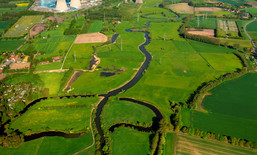Measure block Heidemühle
Heidemühle is the name of the measure block in the eastern end of the four separate sections in which the actions concerning the LIFE+ project take place. At the same time, it is the easternmost end of the FFH (Flora Fauna Habitat) area called “Lippeaue between Hangfort and Hamm”.
This section can be separated into the northern part (situated on the right hand side of Lippe’s flow direction) and the southern part (left hand side of Lippe’s flow direction).
Currently, the implementation of actions in the section Heidemühle has not been introduced yet. If you also wish further information on the other three measure blocks, you can find it on the left of this page.
The following actions are planned to be taken soon in the section Heidemühle:
1. Removal of Bank Reinforcement
The unleashing of a river means the removal of bank reinforcement by means of enrockments. It is affected over a distance of several hundred metres of the Lippe. This demolition action is carried out to recreate its natural dynamics and to give it back its freedom to move. As a positive consequence of this unleashing measure, steep banks and shallow water zones will develop over the course of time, which are - contrary to the yet uniform embankments – very rich-textured habitats.
2. Creation and Optimization of Floodplain Basins
Floodplain basins are natural sinks rich in structure and species and link the floodplain – river system in times of high water levels. In the last centuries, however, floodplain basins were often filled and levelled for a better use of agricultural areas. That is why today they are difficult to recognize. Many times they can only be identified by the help of historical maps. As floodplain basins have an impact on the water balance of a river and its floodplain, they are of major importance as a habitat for many species like certain water birds (see floodplain habitats). Therefore, we are planning to create a “new” floodplain basin in the southern section of the measure block Heidemühle.
3. Creation of Standing Water Bodies and Shallow Ponds
Standing water bodies are a part of formerly natural floodplains and serve many varied amphibians, dragonflies, fish and birds as a vital habitat (also see floodplain habitats). Standing water bodies are much deeper than shallow ponds and are therefore protected against drying. This means that they bear water year-round and offer an ideal habitat to the so-called “still water species”, i. e. species which do not like streaming. As small ponds fall dry periodically, they are not a habitat for fish but especially for small animals like amphibians and nymphs enjoying the safety of this habitat.
In the past, many standing water bodies and small ponds were also affected by the agricultural, economic utilization of land due to fillings and drainage. Many ecologically important habitats were lost by these actions.
In the southern section of Heidemühle, most certainly near Hammersch, we are planning to create standing water bodies and at least one small pond.
4. Re-water Logging and Development of Marsh Land
Grassland areas used to be wet in the floodplains and were often submerged for many weeks especially in the winter season. From time to time, the floodplain meadows changed into water bodies of wide extension and were an attractive habitation particularly for water birds as well as for frogs, efts and other amphibians.
Marsh lands are often areas where big cane brakes develop, which are attractive breeding grounds with rich food supply for dragonflies and reed liking bird species like reed warblers. The extension and accumulation of existing drainage ditches is intended to attribute to re-water logging of meadows and grazing lands in the northern part of the measure block Heidemühle. In the southern section (near Mühlenbach) there is a plan for re-water logging by creating a marsh land area. All in all, ground level re-water logging measures in the measure block Heidemühle are planned to cover an area of 5.2 ha.
5. Transferring Ditches
Many drainage ditches alongside the Lippe do not end in it anymore. This impedes the exchange of dike water and river water and makes it difficult for various small animals to migrate the Lippe alongside the dykes. Therefore, we are planning to transfer ditches in the northern part of the measure block Heidemühle near Totenmersch. Currently, this ditch does not have any contact to the Lippe but is intended to end directly in a part of its sinuosity. The length of this ditch transfer will account for 300 metres.
6. Extensive Agricultural Utilization of Land
This means gentle pasturing of grassland or its use for swathe. An extensive utilization of agricultural areas is planned within the whole measure block Heidemühle. Especially wet meadows and areas without trees offer a vital habitat to many birds breeding at ground level. An extensive way of pasturing grassland is to keep ungulates. This measure keeps the areas free of high vegetation cover.

